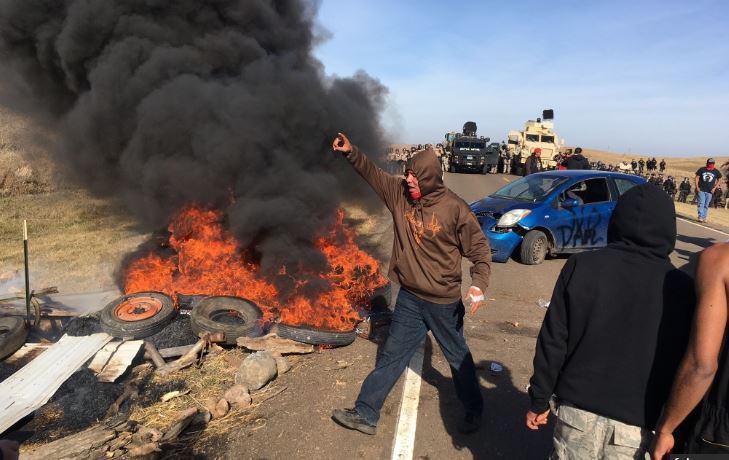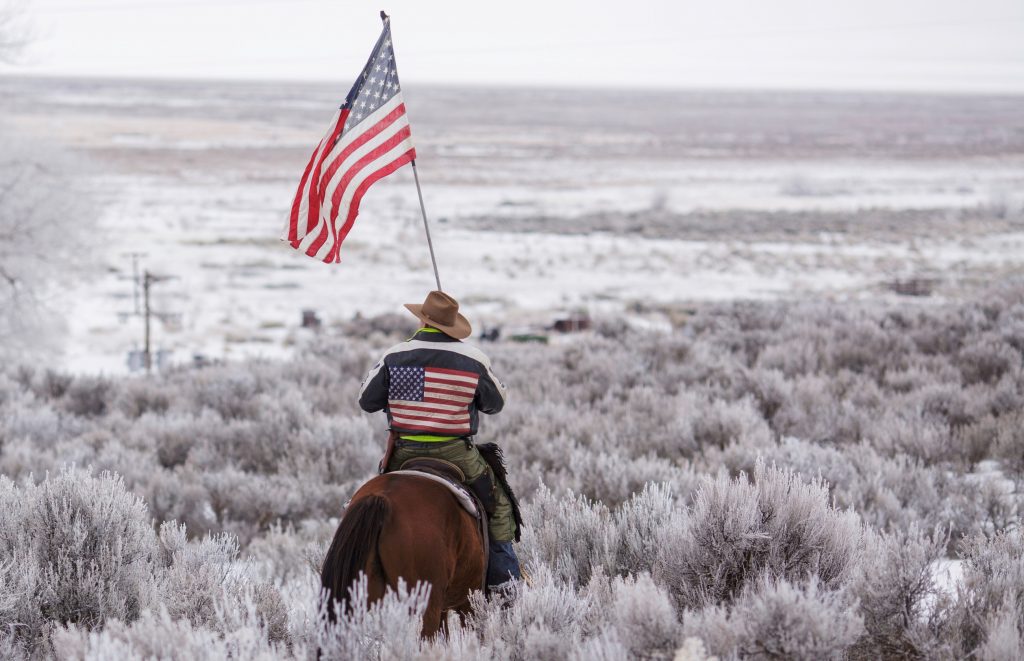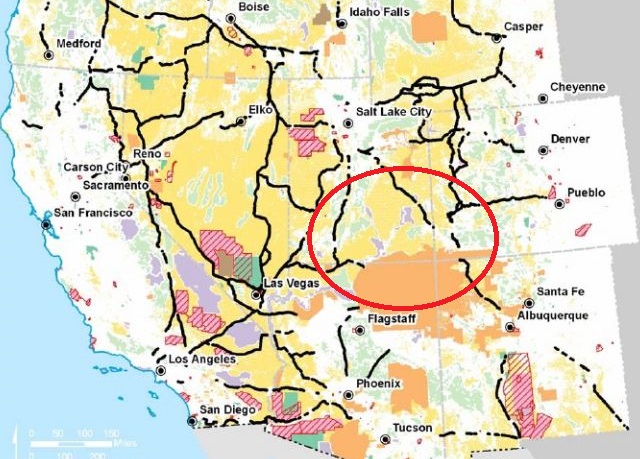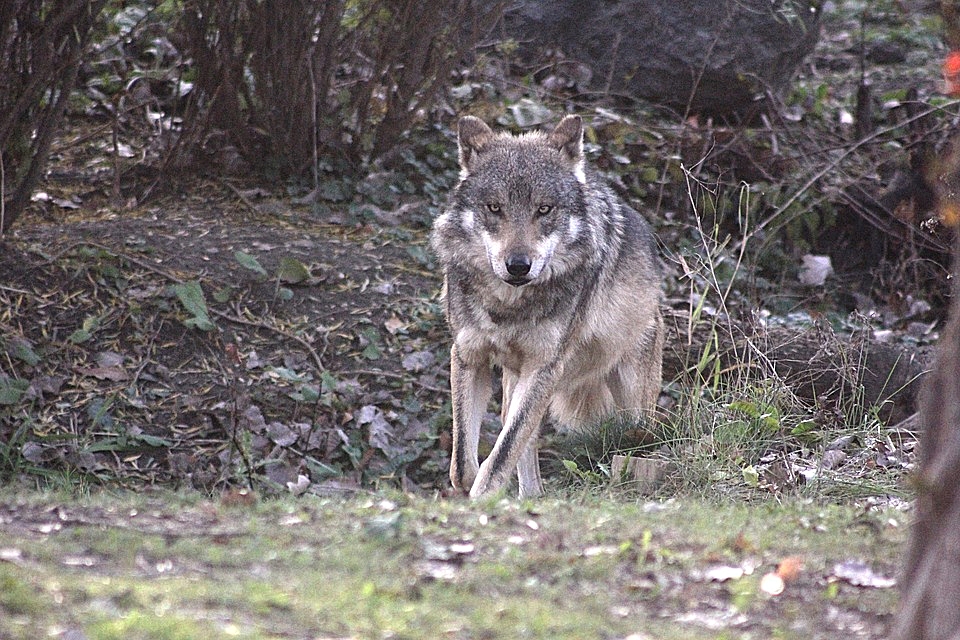The physical confrontations heated up when the DAPL crews started coming into the area with bulldozers, moving topsoil, heading toward the river. One rancher has reported missing, killed or maimed livestock, but investigations are incomplete.
Protesters put ranchers on edge
ST. ANTHONY, N.D. — Jared Ernst has always kept firearms nearby as he operates his ranch in south-central North Dakota, but since the Dakota Access Pipeline protest, he’s been more obvious about it.
“If they see it, maybe they won’t confront the person,” Ernst says. He described uncomfortable brushes with protesters but, like most ranchers in the area, couldn’t say he felt threatened.
Jared, 34, grew up on a farm near Edgeley, N.D. He graduated from Bismarck State College in agricultural business management in 2002 andoperated his own truck business forseveral years as he worked on a ranch west of Lemmon, S.D. He met Virginia Miller in 2011 and they were married in 2012, the year they moved to her farm and dubbed it the J Bar E Ranch, raising commercial cattle, registered Angus and alfalfa. The headquarters is about 18 miles west of the Missouri River, through country where the Dakota Access Pipeline is to be built, and where “water protectors” have staged events.
Water quality is important to the Ernsts. Their ranch gets livestock water from a well that is 280 feet deep and draws water underlying the ranch. For the house, they use Missouri West Water Systems, a rural water company based in Mandan, which they use that if the wells aren’t working.
Ernst says, when he moved here four years ago, he knew there were gas lines from a previous pipeline that goes under the Missouri River. “It was put here in 1982, the year I was born,” he says. “The current pipeline now is being placed right next to it. Everything was surveyed before. It should be easy, but apparently not.”
Water quality
Ernst became aware of the protest camp, started by Standing Rock Tribe members, in late August. Later, it evolved from hundreds of protesters into thousands of people, and has since created a series of road blockages and checkpoints. The physical confrontations heated up when the DAPL crews started coming into the area with bulldozers, moving topsoil, heading toward the river. One rancher has reported missing, killed or maimed livestock, but investigations are incomplete.
On Sept. 6, at 11:22 a.m., Ernst was checking cows when he saw two pickups with South Dakota and Nebraska license plates and a stock trailer in one of his alfalfa fields. About eight men were unloading six horses, preparing for a protest event on a day when some protesters later vandalized pipeline equipment.
“I drove down and told them they were in my alfalfa fields,” Ernst says. “They were mostly Native Americans, and most had masks over their faces. I exchanged words with two of them. I asked him to leave; this is private property. He told me this was ‘tribal’ or ‘treaty’ land, and that I didn’t have a right to be there.”
A couple of younger members of the group trotted up on horseback, asking him why he wasn’t standing with the protestors. One swung a lariat in a threatening way. An older member of the group told the younger members to calm down and stay back.
“I didn’t know if they were going to rope me there like they would in the movies, or if they were just goofing off,” Ernst says. A highway patrolman showed up on the scene and privately asked Ernst, “Why can’t they just stay here?”
“‘Because it’s private property and I want them off,’” he told the patrolman. “He asked, ‘Where are they supposed to go?’ And I told him ‘I don’t care where they go, as long as they’re not on my field anymore.’”
Pushing buttons
On Oct. 15, a group of protesters walking toward the pipeline made noise as they approached his portable corral system. Their noise spooked the cows, causing them to run over the hills, never to return. Ernst had other cases where he was trying to check cattle and had to drive through a gauntlet of vehicles for protesters staging events.
“If they are protesting, a lot of times roads are closed, so you have to add 20 miles to the trip of going to check cows, hauling hay — anything like that,” he says. Law enforcement is everywhere and from everywhere. “It kind of creates a hardship, because you don’t know if you’ll get everything done in a day that you expected to. It would have been nice if they’d been a little more respectful of people who are here, trying to make a living.”
Packing heat
Virginia Ernst says she feels unsafe in her community. “There’s some that want it to be peaceful, but there is that handful that are way more aggressive than the majority are,” she says. In the beginning, the Standing Rock officials were in control, but that control has been lost to the mass of the event.
Jared Ernst carries a revolver in a holster on his hip.
The National Guard makes its rounds within the community for welfare checks with farmers and ranchers, and recently stopped at the Ernst ranch.
“I’m hoping something doesn’t happen,” Virginia says, noting there are three concealed weapons classes going in the area. She thinks a majority of the people are carrying weapons.
“They say they’re peaceful, but with the vandalism that has been done, it kind of makes a person nervous,” Jared says. “They say they don’t have any weapons on them, but anything can be a weapon if you want to cause harm to somebody. Just because it’s not a firearm don’t mean they don’t have weapons.”
Cutting wire
Some ranchers, who decline to be identified, say protesters cut fences as they make their way to pipeline equipment.
Protesters west of St. Anthony tore out more than 200 yards of barbed wire fence and threw it in a hole the pipeline had dug beneath a road, presumably as a deterrent against construction. The rancher was in the middle of grain harvest but had to rebuild fence instead.
“Everybody’s got a right to protest,” Jared says. “I haven’t had a problem with that from day one.”
He disagrees the threat to the environment is as serious as protesters think, but he acknowledges there is always a possibility of a failure. “With technology, the chances for that are minimal, I feel,” he says.
“I don’t feel they should have the right to terrorize — photograph, take video, pictures of license plates,” he says. “It makes people nervous about what their intentions are. If they want to stand along the road, hold up banners, chant and pray, that’s fine, but let the traffic flow.”
One rancher, who declines to be identified, says he was irritated his children’s school bus had to have a police escort and didn’t dare travel on some gravel roads in the area, bypassing some homes in the area. Some neighbors, he says, have been “shook up” by harsh language from belligerent protesters on their roads.
Multiple unknowns
Chad Ellingson and his wife, Julie, who is the executive director of the North Dakota Stockmen’s Association), have a ranch within a half-mile of the pipeline construction. The Northern Border natural gas pipeline is also on their property, constructed in the same right-of-way about 35 years ago.
The pipeline construction has brought a large number of unknown vehicles into the community, but the protesters have tripled that, Chad says. He says the federal government has “laid a lot on the laps of North Dakota” and has stayed aloof. “They need to be here policing this, giving aid to North Dakota to protect the landowners and residents here, but also the people that come here to protest and the people who come here to work,” he says.
The Ellingsons haven’t had protesters on their ranch, but had “a lot of encounters” with them on roadways, Chad says.
He’s had fences for access to the pipeline right-of-way, which he says is “uncalled for in North Dakota, or anywhere,” calling the protesters’ movement across private land just as disrespectful as it would be in urban neighborhoods. “That’s not how we’re supposed to treat each other in North Dakota; everybody is supposed to respect each other.” He thinks the protesters must know that the fences are private property and don’t belong to the pipeline.
Chad also calls the videotaping unnecessary. “Getting right into your face, trying to videotape you: I don’t know the reason for that,” Ellingson says, soberly. “I think it’s an intimidation move. It’s not so much of a scare for us as an adult,” but it’s a fear that ‘re putting into the kids.
His daughter, Sheridan, 8, says she sees protesters “hanging around,” and says the whole idea of intruders worries her about being on her own home ranch.
“Farmers and ranchers hang pretty tough,” Ellingson says. “When the tough get going, they get going tougher. We can withstand this. We’ll put up with it as it crosses our land. We’ll put up with the protesters. I don’t want it to become a conflict. I don’t want bloodshed, and hopefully most of the protesters don’t want that either. Hopefully it will come to a peaceful ending.”
Mikkel Pates

 Agweek’s Mikkel Pates recently spent several days in the Dakota Access Pipeline protest area, south of Mandan, N.D. In a two-part series, Pates interviews farmers and ranchers who maintain land in the wake of the nationally recognized protests. This week, Agweek features ranchers whose lifestyles and harvest have been affected.
Agweek’s Mikkel Pates recently spent several days in the Dakota Access Pipeline protest area, south of Mandan, N.D. In a two-part series, Pates interviews farmers and ranchers who maintain land in the wake of the nationally recognized protests. This week, Agweek features ranchers whose lifestyles and harvest have been affected.


I am so happy that this never happened to me with my fences and cows on my land unless you have ranched you have no idea how protective ranchers will get.